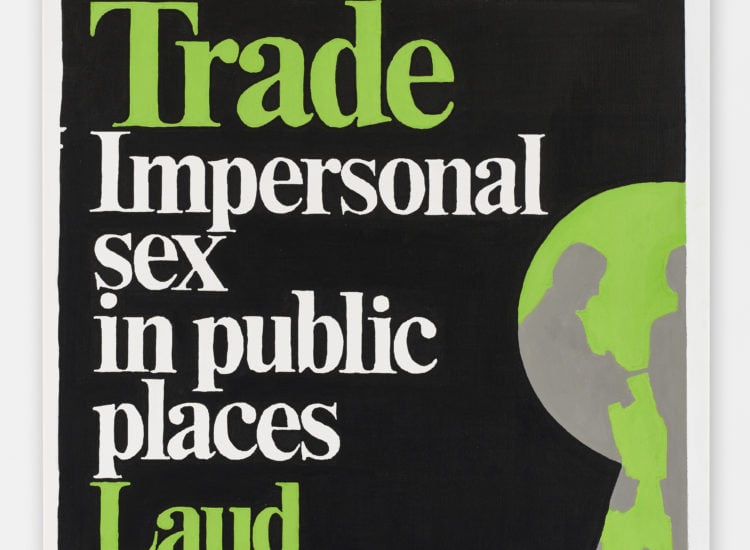Reviews
Scholar of ‘Smut’: Dean Sameshima Celebrates and Memorializes Gay Cultural History at Peres Projects
His paintings are a tribute to the expressive and sexual freedoms afforded by the city of Berlin.
His paintings are a tribute to the expressive and sexual freedoms afforded by the city of Berlin.

Dean Sameshima’s practice in “647 (a),” his seventh show with the Peres Projects Gallery, remains both scholarly and highly personal. Sameshima engages in autobiography by proxy: He tells his own story through his media consumption while also presenting gay cultural history.
Repression, persecution, nostalgia for prelapsarian decadence, sexual adventure, and his own journey to understand himself within a specific lineage of cultural references are poignantly expressed in his reserved paintings. He combines evidence of his experiences as a gay man whose relationship with sex and death was shaped by the specter of AIDS with his identity as a fan, and his fight for certain reference-points and artifacts of gay culture not to be forgotten.
He also creates a haunting and timely reminder for Berlin audiences of all sexualities not to take the city’s precious freedom for granted.
Seen from a distance, Sameshima’s paintings appear coolly, even mechanically, reproduced but their humanity and intimacy become apparent when they are approached closely. Pencil marks, slight asymmetry and differences in Sameshima’s meticulous paint application demonstrate that his emotional and intellectual investments motivate his loving renderings of replicated or collaged citations. In Tricks: 25 Encounters 1996 (2017), for example, Sameshima includes pale blue lines, supposedly his pen marks underlying pertinent sections in a personal copy of Renaud Camus’s eponymous fictional short-story collection. Published in the “High Risk Books” series at Serpent’s Tail press, Camus recounts tales of cruising in Paris, Milan, New York, and San Francisco before the era of AIDS.
AIDS is invisible but omnipresent throughout “647 (a)”. As observed by Nick Koenigsknecht, the recently appointed partner at Peres Projects, Paris is Burning, 1990, Sameshima’s 2017 black canvas showing only the white words “New York, 1987,” looks like a tombstone. This homage to the iconic documentary depicting the defiant creativity in Harlem’s underground drag balls and vogueing competitions stripped away his referent’s exuberance and glamour but draws attention to queer survival and life-affirmation under homophobia, racism, poverty and the relentless menace of AIDS.
Sameshima directly includes his own experiences, too. Tearoom Trade: Impersonal Sex in public places. Enlarged edition with a retrospect on ethical issues, 1975, is a meticulously reproduced cover of Laud Humphrey’s book which controversially outed several of its subjects. This 2016 painting ties into the show’s title—which cites the penal code for public sex in Sameshima’s arrest record, which he reproduced on five canvases for a 2016 show in Los Angeles. He also pays homage to George Michael as an erotic eulogy in City Men: George Michael, 2017, a reproduced ticket stub from Sameshima’s commemorative trip to a Berlin cruising kino on the day Michael died, an act of remembrance for the singer’s heroic refusal to be shamed when he was arrested for public sex.
Its most meaningful effect is achieved when Sameshima adds denser black paint under Christopher Isherwood’s name in a back-cover blurb for States of Desire, a wry and revealing city-guide to gay sex in the 1970s by Edmund White. By drawing attention to Isherwood’s name, Sameshima makes his show solemnly relevant to viewers in Berlin of all sexualities. Isherwood’s Berlin Stories is an iconic representation of Weimar Germany immediately before the onset of the Nazi police state. In the present day political climate, Berlin’s freedoms, including its sexually fluid, outlaw subcultures and artistic identity, again feel fragile, and the ultimate message of “647(a)” is a reminder to know one’s history and feel gratitude for today.
Dean Sameshima, “647 (a),” is on view at Peres Projects, Berlin from March 10 – April 10, 2017